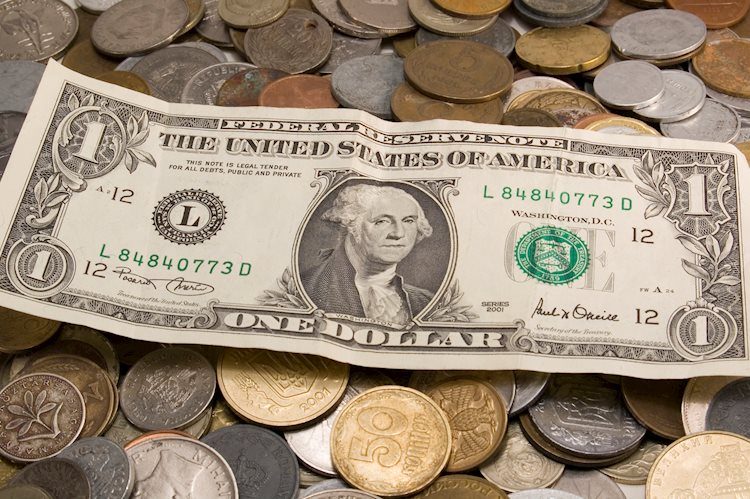
- US Dollar starts the month of May on a firm footing, gathers strength against its major rivals.
- US Dollar Index climbed to its highest level in three weeks above 102.0.
- Federal Reserve’s policy meeting could significantly influence the US Dollar’s valuation this week.
The US Dollar gathered bullish momentum on Monday and the US Dollar Index (DXY) rose more than 0.5% on a daily basis, fueled by a more than 4% increase seen in the benchmark 10-year US Treasury bond yield. The DXY continued to push higher and touched its highest level since April 11 at 102.40.
With the benchmark 10-year US Treasury bond yield falling sharply after the latest US data, however, the US Dollar lost some strength with the DXY returning to 102.00 area in the American session.
The Federal Reserve’s (Fed) two-day policy meeting gets underway on Tuesday and the policy decisions will be announced on Wednesday. Although markets are fairly certain that the Fed will raise its policy rate by 25 basis points (bps) to the range of 5%-5.25%, the language in the policy statement regarding a pause in the tightening could influence the USD’s valuation significantly.
Daily digest market movers: US Dollar stays resilient ahead of Fed policy announcements
- The data published by the US Census Bureau revealed on Tuesday that new orders for manufactured goods, Factory Orders, increased $4.9 billion, or by 0.9%, to $539 billion in March.
- The US Bureau of Labor Statistics (BLS) announced that the number of job openings on the last business day of March stood at 9.59 million, compared to 9.97 million in February. This reading came in below the market expectation of 9.77 million.
- The 10-year US T-bond yield turned south and broke below 3.5% after the US data, limiting the US Dollar’s gains.
- Wall Street’s opened in negative territory on Tuesday with the Dow Jones Industrial Average losing nearly 1% on a daily basis.
- The ISM Manufacturing PMI improved slightly to 47.1 in April from 46.3 in March. This reading showed that the contraction in the manufacturing sector’s activity continued, albeit at a softer pace.
- The ISM’s survey further revealed that the Price Paid sub-index, the input inflation component, climbed to 53.2 from 49.2, playing into the hawkish Fed narrative.
- Previewing the FOMC event, “we anticipate that post-meeting communication will: (i) emphasize that disinflation has been evolving slower than expected, leaving open the possibility of additional tightening, and (ii) acknowledge the more uncertain economic environment, especially with regard to credit conditions post SVB collapse,” said TD Securities analysts.
- The CME Group FedWatch Tool shows that markets are pricing in a 96% probability of a 25 bps Fed rate increase on Wednesday.
- US regulators seized First Republic Bank and agreed to sell a majority of its assets to JPMorgan Chase & Co. Last week, the bank reported that there were more than $100 billion of deposit outflows in the first quarter.
- The data from the Eurozone showed on Tuesday that the annual Core Harmonized Index of Consumer Prices (HICP) declined to 5.6% in April from 5.7% in March.
- The European Central Bank (ECB) noted in its Bank Lending Survey that a net 38% of Eurozone banks reported a fall in demand for credit from companies in the first quarter of the year.
- “The general level of interest rates was reported to be the main driver of reduced loan demand, in an environment of monetary policy tightening,” the ECB explained in its publication, weighing on EUR/USD.
- The ECB will announce its monetary policy decisions on Thursday.
Technical analysis: US Dollar Index holds above key support level
The US Dollar Index (DXY) closed above the 20-day Simple Moving Average (SMA) for the first time since mid-March on Monday. Moreover, the Relative Strength Index (RSI) indicator recovered above 50, pointing to a bullish shift in the short-term outlook.
On the upside, the DXY faces interim resistance at 102.60 (static level) ahead of 103.00/103.20 area, where the 50-day and the 100-day SMAs are located. A daily close above the latter could bring in additional buyers and open the door for an extended rally toward 104.00 (psychological level).
102.00 (former resistance, static level, 20-day SMA) aligns as first support. If DXY fails to hold above that level, 101.50 (static level) and 101.00 (psychological level) could be seen as next bearish targets.
How does Fed’s policy impact US Dollar?
The US Federal Reserve (Fed) has two mandates: maximum employment and price stability. The Fed uses interest rates as the primary tool to reach its goals but has to find the right balance. If the Fed is concerned about inflation, it tightens its policy by raising the interest rate to increase the cost of borrowing and encourage saving. In that scenario, the US Dollar (USD) is likely to gain value due to decreasing money supply. On the other hand, the Fed could decide to loosen its policy via rate cuts if it’s concerned about a rising unemployment rate due to a slowdown in economic activity. Lower interest rates are likely to lead to a growth in investment and allow companies to hire more people. In that case, the USD is expected to lose value.
The Fed also uses quantitative tightening (QT) or quantitative easing (QE) to adjust the size of its balance sheet and steer the economy in the desired direction. QE refers to the Fed buying assets, such as government bonds, in the open market to spur growth and QT is exactly the opposite. QE is widely seen as a USD-negative central bank policy action and vice versa.